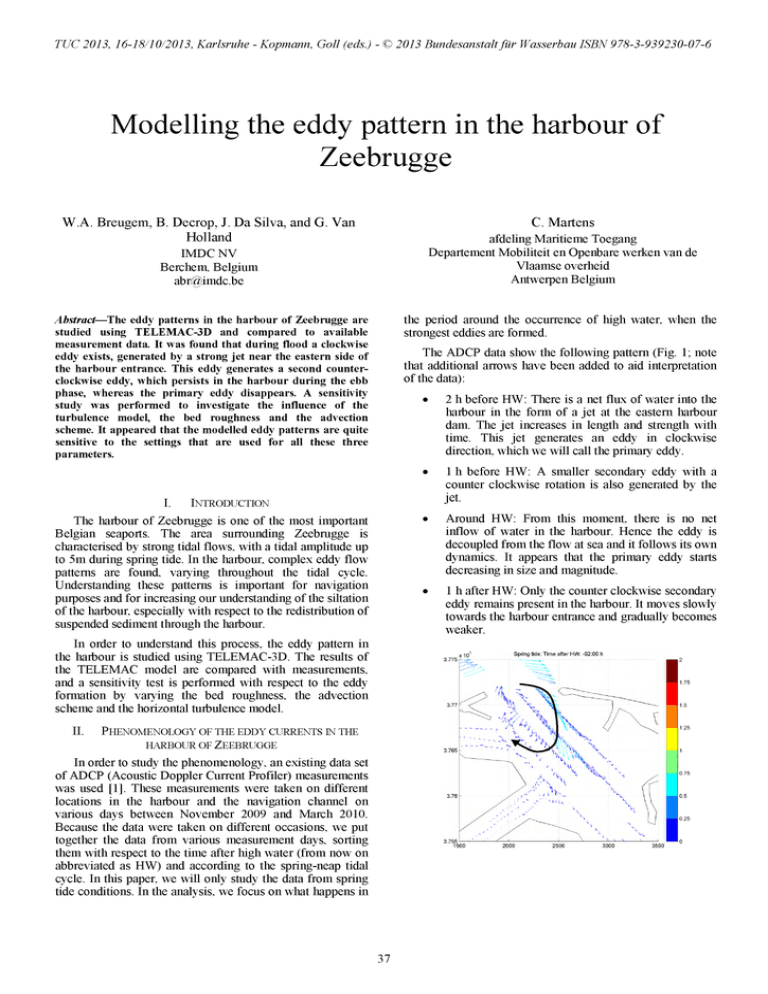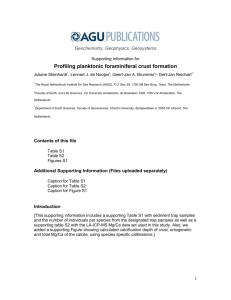Document 11770658
advertisement

TU C 2013, 16-18/10/2013, Karlsruhe - Kopmann, GoII (eds.) - © 2013 Bundesanstalt fü r Wasserbau ISBN 978-3-939230-07-6 Modelling the eddy pattern in the harbour of Zeebrugge W.A. Breugem, B. Decrop, J. Da Silva, and G. Van Holland C. M artens afdeling Maritieme Toegang Departement Mobiliteit en Openbare werken van de Vlaamse overheid Antwerpen Belgium IMDC NV Berchem, Belgium abr@imdc.be the period around the occurrence of high water, when the strongest eddies are formed. Abstract—The eddy patterns in the harbour of Zeebrugge are studied using TELEMAC-3D and compared to available measurement data. It was found that during flood a clockwise eddy exists, generated by a strong jet near the eastern side of the harbour entrance. This eddy generates a second counter­ clockwise eddy, which persists in the harbour during the ebb phase, whereas the primary eddy disappears. A sensitivity study was performed to investigate the influence of the turbulence model, the bed roughness and the advection scheme. It appeared that the modelled eddy patterns are quite sensitive to the settings that are used for all these three parameters. I. The ADCP data show the following pattern (Fig. 1; note that additional arrows have been added to aid interpretation of the data): 2 h before HW : There is a net flux of water into the harbour in the form of a jet at the eastern harbour dam. The jet increases in length and strength with time. This jet generates an eddy in clockwise direction, which we will call the primary eddy. • 1 h before HW : A smaller secondary eddy with a counter clockwise rotation is also generated by the jet. • Around HW: From this moment, there is no net inflow of water in the harbour. Hence the eddy is decoupled from the flow at sea and it follows its own dynamics. It appears that the primary eddy starts decreasing in size and magnitude. • 1 h after HW: Only the counter clockwise secondary eddy remains present in the harbour. It moves slowly towards the harbour entrance and gradually becomes weaker. In t r o d u c t io n The harbour of Zeebrugge is one of the most important Belgian seaports. The area surrounding Zeebrugge is characterised by strong tidal flows, with a tidal amplitude up to 5m during spring tide. In the harbour, complex eddy flow patterns are found, varying throughout the tidal cycle. Understanding these patterns is important for navigation purposes and for increasing our understanding of the siltation of the harbour, especially with respect to the redistribution of suspended sediment through the harbour. In order to understand this process, the eddy pattern in the harbour is studied using TELEMAC-3D. The results of the TELEMAC model are compared with measurements, and a sensitivity test is performed with respect to the eddy formation by varying the bed roughness, the advection scheme and the horizontal turbulence model. II. • P henom enology 3 775 o f t h e e d d y c u r r e n t s in t h e HARBOUR OF ZEEBRUGGE 3.765 In order to study the phenomenology, an existing data set of ADCP (Acoustic Doppler Current Profiler) measurements was used [1], These measurements were taken on different locations in the harbour and the navigation channel on various days between November 2009 and March 2010. Because the data were taken on different occasions, we put together the data from various measurement days, sorting them with respect to the time after high water (from now on abbreviated as HW) and according to the spring-neap tidal cycle. In this paper, we will only study the data from spring tide conditions. In the analysis, we focus on what happens in 3.76 2000 37 2500 XXth TELEMAC-MASCARET User Conference Karlsruhe. October 16-18. 2013 Spring tide; Time after HW: 02:00 h Spring tide; Time after HW: -01:00 h .775 .77 .765 .76 .755 — 1500 2000 2500 3000 3500 Figure 1. Overview of the eddy development in the harbour o f Zeebrugge from ADCP measurements. Spring tide; Time after HW: 00:00 h Comparable eddy patterns are found in the measurements during average tide, whereas the formation of this pattern is much less pronounced during neap tide. One must take care when interpreting the measured data, because the presented data was collected during different measurement days. There is always some error associated with the matching procedure, because the tidal amplitude and period are not completely the same for the different measurement days. Nevertheless, the discussed pattern seems to be representative for the conditions occurring in the harbour, since earlier data [2] show similar results for the observed eddy patterns. III. M o d el setup The model was set up in a circular domain centred around the harbour of Zeebrugge, starting from Dunkirque (France) in the West to Goeree-Overflakkee (the Netherlands) in the East (Fig. 2). The Eastern and Western Scheldt estuaries are included in the model, although the most upstream part of the Western Scheldt was schematized using straight prismatic channels. The resolution varied from 30 m inside the harbour to 5000 m close to the open boundary (Fig. 3). Vertically, ten non-equidistant sigma layers were used to represent the water column. Spring tide; Time after HW: 01:00 h Boundary conditions for velocity and water level were obtained from the Zuno [3] model, which has a resolution comparable to our model at the location of these boundaries. These boundary condition were applied as a time series (with a time interval of 10 min) at each location on the open boundary. Additional discharge boundary conditions were applied to schematise fresh water influxes into the model. Note that one of the sources of fresh water was located inside the harbour. The model was ran in TELEMAC-3D for a period of 15 days using a time step of 20 seconds using the Smagorinsky scheme for the horizontal eddy viscosity and a mixing length model using the mixing length parameterization of Nezu and Nakagawa [4] for the vertical eddy viscosity. 38 XXth TELEMAC-MASCARET User Conference ■ Karlsruhe. October 16-18. 2013 A comparison of measurement data and model results for the water level time series showed typical bias of 0.1 m, and a root mean squared error (nns) of 0.15 m. The depth averaged velocities have a bias of -0.04 m/s and a nns error of less than 0.13 m/s. A comparison of high water and low water levels shows typical nns enors of 0.13 m, while a comparison of the high and low water levels resulted in a typical nns enor of 10 min. These enors compare well with those of the Zuno model that was used for the open boundaries [3] and they were considered sufficiently accurate for our purposes. BOTTOM 7.5 ■ o -7 .5 -15 -22 5 -3 0 -3 7 .5 -45 -52.5 -60 IV. Figure 2. The results of the model are shown in Fig. 5. The model reproduces the strong jet found in the measurements, although it occurs somewhat later in the tide (Fig. 5a). In the model, the jet seems to be even more pronounced than in the measurements. However, the jet is located somewhat more to the east in the model than in the measurements. The model also shows a strong primary eddy. Further, the jet also generates a secondary circulation which is weaker than the primary eddy (Fig. 5b). Mesh and bathymetry o f the model ■ BOTTOM -2 -4 -6 -a -10 -1 2 -14 -16 -18 -20 _ Approximately one hour after high water both the primary and secondary eddy are present in the model results (Fig. 5c). With the course of time, the primary eddy elongates and decreases strongly in strength, while the decrease of the secondary eddy is less. As a result of this process, the primary eddy disappears completely, just as seen in the measurements (Fig. 5d). However, in the model a very weak tertiary eddy developed north of the primary eddy, with the same direction of rotation as the secondary eddy. This eddy could not be observed in the measurements. The reason for this is probably that it is to weak and small to be observed with the relatively limited spatial resolution provided by the ADCP measurements. ■ Figure 3. Detail o f the mesh close to the harbour The model was calibrated using water level and velocity data at sea. This leads to a Manning roughness coefficient of 0.02 s/m13. Close to the harbour entrance, the friction coefficient was increased, in order to represent the effect of the friction due to the large concrete elements of the breakwater (Fig. 3). Time after HW -00:20 BOTTOM FRICTION 0.032 0.028 0 024 0.02 0.016 0.012 0.008 Figure 4. RESULTS Manning roughness coefficient close to the harbour 39 XXth TELEMAC-MASCARET User Conference Karlsruhe. October 16-18. 2013 Time after HW: 00:40 V. S e n s it iv it y a n a l y s is A. Bed roughness In order to assess the sensitivity towards the bed roughness on the formation of the eddy patterns, we eliminated the increased bed rouglmess at the harbour entrance. Thus the simulation was done using a constant Manning rouglmess coefficient of 0.02 s/m13. The modelled eddy pattern changes dramatically in comparison with the base run (Fig. 6). At first, we see the same jet developing (Fig. 6a). However, it lias a slightly different location. This gives the primary eddy a slightly stronger circulation and the secondary circulation that develops is slightly weaker than in the base run (Fig. 6b). Consequently, the primary eddy does not disappear with time (Fig. 6c). Thus we end up with two eddies in the harbour during the ebb phase, rather than one (Fig. 6d), which does not correspond to the measurements. 3./ e - b. Tim e after HW: -00:20 Time after HW: 01:40 / f , \ \ \ 3.76 1500 C. Tim e after HW: 02:40 3.77 3.765 V \ \ 1500 V \ \ I I \ / t i 3.755 1500 2500 b. d. Figure 5. Development o f the modelled eddy pattem (base ran) 40 2500 3000 XXth TELEMAC-MASCARET User Conference Karlsruhe. October 16-18. 2013 ■ Figure 6. Figure 7. Modelled eddy patterns, without increased bottom friction at the break waters. Modelled eddy patterns using the "N-scheme" C. Turbulence modeling/eddy viscosity In order to test the sensitivity toward the used horizontal turbulence model a model with a constant horizontal eddy viscosity of 1.0 nr/s was used. This value is somewhat higher than those calculated using the Smagorinsky scheme used in the other runs, which were in this area in the order of IO'2 nr/s. B. Advection scheme The previous simulations were done using the characteristic method as advection scheme for the advection of velocity. In order to test the sensitivity toward the used advection scheme, computational runs were performed using the two schemes that were especially suited to use in combination with the use of tidal flats: the “Leo Postma scheme” and the “N-scheme”. The use of a high eddy viscosity coefficient weakens the jet at the harbour entrance (Fig. 8a). The secondary eddy develops but is weaker than the primary eddy (Fig. 8b). Therefore, in this situation only the primary eddy remains in the harbour during the start of the ebb phase (Fig. 8c), and it is stronger than the secondary eddy. Nevertheless, the primary eddy disappears eventually, leading to a flow direction that corresponds to the measurements (Fig. 8d). Once again, the resulting eddy patterns change dramatically compared to the base ran (Fig. 7) Note that for brevity, only two time steps for the N-scheme are shown. The Leo Postma scheme gave qualitatively similar results). In fact, the eddy pattern that develops is rather similar to the simulation without bottom friction at the breakwaters (section V.A). We see both a primary eddy and a secondary eddy, with the primary eddy being slightly stronger than the secondary eddy. 41 XXth TELEMAC-MASCARET User Conference Karlsruhe. October 16-18. 2013 Time after HW: -00:20 I 0.6 d. Tim e after HW: 00:40 Figure 8. Model results with a constant eddy viscosity o f 1.0 n f/s Note that simulations with a constant eddy viscosity of 0.01 nr/s (thus comparable with those calculated using the Smagorinsky model) gave similar results for the eddies as the base run. VI. 3.765 a n d c o n l u s io n s A TELEMAC-3D model was developed in order to study the eddy patterns occurring in the harbour of Zeebrugge. It appears that a strong jet is formed some time before high water during the moment of strongest inflow. The jet generates a clockwise and a counter clockwise eddy, from which only the counter clockwise eddy remains visible during the ebb phase. A comparison between ADCP measurements and the model showed that this behaviour could be simulated using TELEMAC. A sensitivity analysis showed that the results are very sensitive to the bed friction close to the edges of the harbour. The used advection scheme and the calculation method for the horizontal eddy viscosity, and the variation of these parameters could lead to a different number of eddies present in the harbour. b. Time after HW: 01:40 s* s' s I ! t f / / / , A cknow ledgem ent ,kl , , Project funded under project nmnber '16EF201116.' assigned by the Maritime Access Division (aMT) of the Department of Mobility and Public Works of the Flemish Government. / y I .. / Su m m a r y s \ V. \ V R eferences 3.76 1500 2500 C. 42 [1] Eurosense and Aquavision, “Stroomatlas Zeebrugge Verwerkingsrapport” 2011 (in dutch) [2] Ministerie van de Vlaamse Gemeenschap, “Stroomatlas haven van Zeebrugge” 1998 (in dutch) [3] Vanlede, J.; Leyssen.G.; Mostaert, F., (2011) Modellentrein CSMZUNO, Deelrapport 1: opzet en gevoeligheidsanalyse. WL Rapporten WL2011R753_12revl_l (in dutch) [4] I. Nezu and H. Nakagawa "Turbulence in Open-Channel Flows", IAHR Monographs, A.Â. Balkema, 1993, 281 pages






